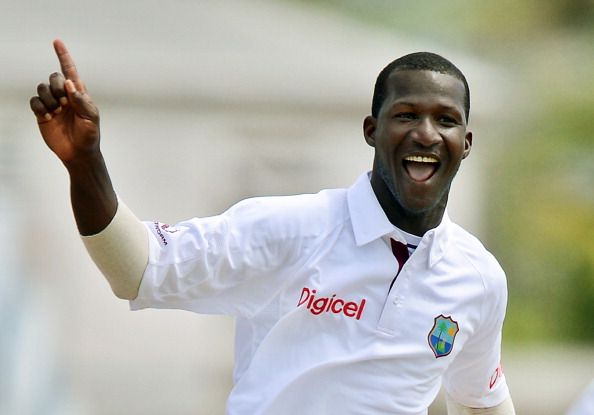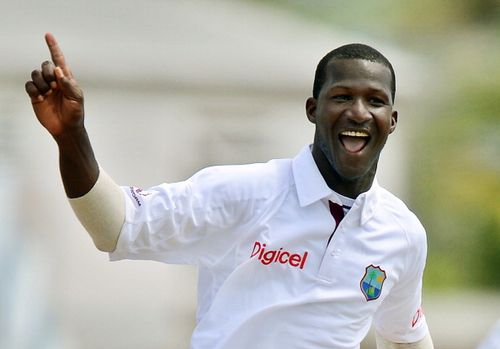
Why India tour is a reality check for Darren Sammy

Success in Test matches has eluded Darren Sammy so far
The debate over Darren Sammy’s position at the helm of the West Indies team in Test matches has been doing the rounds for quite some time now. The recent defeat in the Eden Gardens Test against India inside three days has spurred fresh criticism and scrutiny regarding his place in the Test team altogether.
Honestly speaking, the West Indies captain hasn’t been in his skin in recent months and his consistent failures in the international arena has left former cricketers and analysts mulling over his inclusion in the Test squad. With the clock steadily ticking against him, the pressure of making a comeback and answering his critics with the willow and the cherry is escalating exponentially.
Last year, Sammy had turned the tables around for the Caribbean islands as he dexterously marshalled his troops in Sri Lanka and led his team to the famous ICC World T20 triumph. He was showered upon with embellished superlatives accompanied by flattering applause and his leadership was sealed under protection in a safety vault.
However, unlike his ascendancy in the limited formats of the game, Sammy has fallen short of maintaining the same standard in Test matches. Leadership is undoubtedly a significant quality, but it alone cannot eclipse the obligatory skills of a Test cricketer.
Ever since his commanding seven-wicket haul against England in his debut Test at Manchester in 2007, Sammy has been an unreliable customer dwelling on the perimeters of inexcusable inconsistency.
When he replaced Chris Gayle as the skipper of the West Indies in 2010, he was merely 8 Tests and 41 ODIs old. In the following tour against Sri Lanka, he was equally dismal with the bat as he was erratic with the ball.
Except for the occasional excellence against Pakistan and Bangladesh, Sammy had disillusioned the crowds so much so that they turned hostile towards him. Outside the 22 yards, Sammy had to deal with journalists and pundits calling for his head and highlighting the inadequacies of his game.
The fact that Sammy prefers to focus more on precision than on pace and swing has rendered him effective in ODIs and T20s. However, Test cricket remains a different ball game altogether, where his medium pace has more often than not failed to provide breakthroughs against defending batsmen.
While his straight seam action helps him to contain the batsmen and feed on their mistakes in the shorter formats, his inability to swing the ball regularly despite pitching on the right line and length makes him unproductive in the Test arena.
Moreover, the recently concluded Test against India witnessed Sammy struggling with a decent line and length in the 12 overs he bowled. While bowling 12 overs out of the 129 that West Indies bowled isn’t something that can be called “leading from the front”, one cannot blame his lack of confidence after being pounded by the Indians all over the park whenever he went wayward.
And this isn’t the only instance of Sammy’s ineffectiveness. In his last 13 Tests, Sammy has recorded 18 scalps at an unflattering average of 51.77 and his strike-rate is as repulsive as 106.0. For someone who unites the players in the dressing room, Sammy falls short of setting an example and inspiring his team through his achievements.
Time and again, Sammy has been referred to as an all-rounder who, albeit lacking grace, can utilize the long handle to his advantage. The tall gentleman with a high back-lift, however, averages 22.00 in 55 innings despite having a century and four half-centuries to his credit.
For someone taking guard at No.7 or No. 8, finishing unbeaten only once in 34 matches isn’t something to be proud of. The reason was pretty evident in the last two innings where Sammy threw away his wicket, courtesy flawed technique.
With a reputation for bowling long spells, Sammy is undoubtedly, the workhorse of the team whose role is to build pressure on the batsmen by restricting them. This logic, however, doesn’t stand in Test cricket, where batsmen are happy to leave everything pitched outside off at a good length.
Not being so much of a strike-bowler himself, Sammy is expected to find it hard to support the other pacers in the team. While his economy of 2.85 summarizes his control over accurate line and length, his strike-rate of 73.7 presents a broader picture of his misery.
In the 25 Tests that Sammy has captained, West Indies have won eight while losing eight and nine encounters have ended in a draw. While his role in infusing a winning environment in the dressing room has been unanimously accepted, his credentials as a cricketer haven’t impressed all and sundry.
With Sammy losing ground, things aren’t quite sunny for the Caribbean islanders who appear alien to the dominance that their predecessors had exercised over world cricket for more than a decade. With almost every cricketer fading into ordinariness, allowing Sammy to follow their path will be not only unfortunate, but also devastating.
Meanwhile, what appears to inspire Sammy to establish himself once again in Test cricket is his fondness towards comebacks. He has been there, done that. All he needs is to do it one more time.